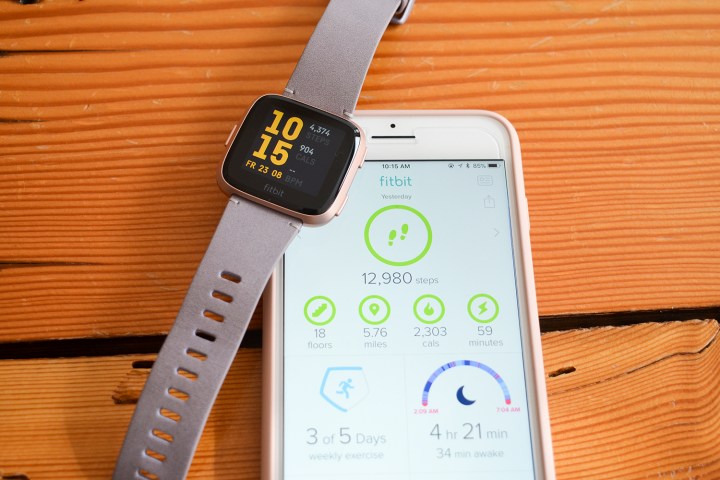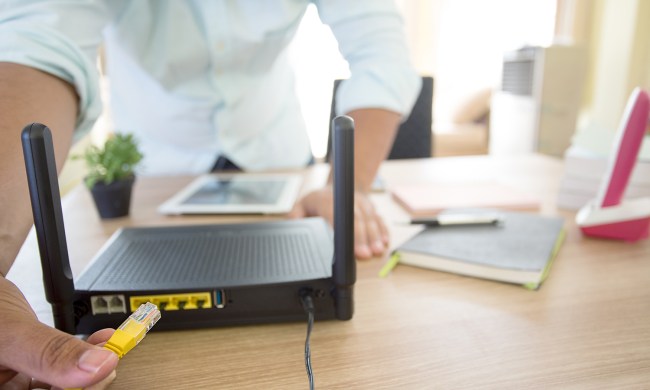
Fitbit fitness trackers and the company’s newly released smartwatches are growing in popularity. Each day, men and women are joining the hoards of fitness freaks and donning a Fitbit fitness tracker or smartwatch to track their steps, evaluate calories burned, and to use as a counterpart for their smartphones.
The less technically savvy might be hesitant to take the leap and purchase their first fitness tracker. But as long as you own a smartphone, tablet, or a PC with Bluetooth capability, you can use a Fitbit. It’s easy to set up and get started and although it may seem daunting, we’ll walk you through the startup procedure — otherwise known as syncing. Here’s how to sync a Fitbit fitness tracker or smartwatch — and everything you need to know about the process.
What is syncing?
Fitbit trackers and smartwatches are equipped with sensors which collect information — including your heart rate, sleep patterns, steps taken, and more — depending on the product you choose. In order to utilize this data, you need to sync it with a smart device such as a phone, computer, or tablet. This allows you to load it onto your Fitbit dashboard.
Your Fitbit dashboard is found in the Fitbit application used in conjunction with the physical device. The Fitbit dashboard allows you to track your progress and compare it to previous days or weeks. The dashboard even shows you how well you sleep each night, if you’re meeting your exercise goals, and also allows you to share information with friends and initiate social challenges.
How to sync your Fitbit tracker or watch
To sync data, Fitbit relies on Bluetooth Low Energy (BLE) technology for its trackers and smartwatches. Bluetooth is a short-range wireless connection which allows you to transfer information between applicable electronic devices. When you sync your Fitbit with a smart device, the collected information is then transferred to your Fitbit dashboard for analysis. Additionally, Fitbit’s scales use Wi-Fi to connect directly to your router.
The Fitbit app is compatible with over Android and iOS, as well as Windows 10 computers. If you have a Mac or a PC running Windows 8.1, you can set up your Fitbit using a program called Fitbit Connect. Fitbit supplies an online resource to help find out if your device is compatible.
Set up your device with the Fitbit app
First, you need to download the Fitbit app from the appropriate application store — Apple (iOS, MacOS), Google (Android, Chrome OS), or Microsoft (Windows), depending on your device’s operating system. Once downloaded, you then need to open it and click Join Fitbit. On-screen instructions walk you through how to properly set up your Fitbit account and pair it with a corresponding smart device. Pairing your device is what allows you to sync data.
Set up your device with Fitbit Connect
Fitbit Connect is a free software application which allows any Fitbit tracker or smartwatch to sync data to your Fitbit dashboard. If your device isn’t Bluetooth-enabled, you need to use a wireless sync dongle in order to set up your Fitbit device. Although most Fitbit devices don’t come with a dongle, you can purchase one through the Fitbit Store.
Once you have a dongle, insert it into the USB port of your computer. Go to the Fitbit setup homepage and select the Download button. Once the file is downloaded, double-click on it to start the installation. Follow the on-screen prompts in order to create a Fitbit account and pair your device.
Syncing

Once your device is paired with the Fitbit app, it syncs data every time you open the app. There is also an All-Day sync feature which syncs your device periodically throughout the day. If you’re using Fitbit Connect as opposed to the application, your device syncs every 15 to 20 minutes when the dongle is plugged in and the device and computer are within a short distance of each other.
How to manually sync your Fitbit tracker or watch
In order to manually sync your device, you first need to open the Fitbit application. Your device also needs to be in close proximity in order for syncing to take place. Search for the picture of your device on the Fitbit app dashboard, then touch it at the top of the screen and pull down
Note: The exception to this is on Windows 10 devices, in which case you would find the picture at the bottom and pull up.
Here’s a step-by-step process for manual syncing different devices:
iPhone or iPad
Go to the Fitbit app dashboard and click the Account icon. From here, find the title of your device and click on it. Tap Sync Now and your device will sync automatically.
Android phone or tablet
Navigate to the Fitbit app dashboard and click the Account icon. Now find the title of your device and select it. There will be arrows located near the Sync Now button — click these to automatically sync your device.
Windows 10 device
Make sure your device is within roughly a 20-foot range of your computer. Plug in your wireless dongle and then head to the Fitbit app dashboard. Next, click the Account icon and choose Advanced Settings. Once you’ve pulled up this screen, switch on the option that reads Fitbit Connect Classic Mode.
It’s recommended you sync your device on a daily basis, if possible. If a device stops syncing, it’s likely due to a connection problem, so be sure to first check your wireless connection. If you’re still experiencing problems syncing your device, visit the Fitbit Help Forum. Alternatively, you can check out the specific ‘Why won’t my Fitbit device sync?‘ forum.









